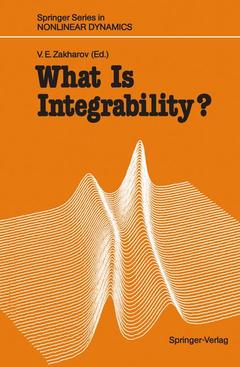What Is Integrability?, Softcover reprint of the original 1st ed. 1991 Coll. Springer Series in Nonlinear Dynamics
Langue : Français
Coordonnateur : Zakharov Vladimir E.

The idea of devoting a complete book to this topic was born at one of the Workshops on Nonlinear and Turbulent Processes in Physics taking place reg ularly in Kiev. With the exception of E. D. Siggia and N. Ercolani, all authors of this volume were participants at the third of these workshops. All of them were acquainted with each other and with each other's work. Yet it seemed to be somewhat of a discovery that all of them were and are trying to understand the same problem - the problem of integrability of dynamical systems, primarily Hamiltonian ones with an infinite number of degrees of freedom. No doubt that they (or to be more exact, we) were led to this by the logical process of scientific evolution which often leads to independent, almost simultaneous discoveries. Integrable, or, more accurately, exactly solvable equations are essential to theoretical and mathematical physics. One could say that they constitute the "mathematical nucleus" of theoretical physics whose goal is to describe real clas sical or quantum systems. For example, the kinetic gas theory may be considered to be a theory of a system which is trivially integrable: the system of classical noninteracting particles. One of the main tasks of quantum electrodynamics is the development of a theory of an integrable perturbed quantum system, namely, noninteracting electromagnetic and electron-positron fields.
Why Are Certain Nonlinear PDEs Both Widely Applicable and Integrable?.- Summary.- 1. The Main Ideas in an Illustrative Context.- 2. Survey of Model Equations.- 3. C-Integrable Equations.- 4. Envoi.- Addendum.- References.- Painlevé Property and Integrability.- 1. Background.- 1.1 Motivation.- 1.2 History.- 2. Integrability.- 3. Riccati Example.- 4. Balances.- 5. Elliptic Example.- 6. Augmented Manifold.- 7. Argument for Integrability.- 8. Separability.- References.- Integrability.- 1. Integrability.- 2. Introduction to the Method.- 2.1 The WTC Method for Partial Differential Equations.- 2.2 The WTC Method for Ordinary Differential Equations.- 2.3 The Nature of ?.- 2.4 Truncated Versus Non-truncated Expansions.- 3. The Integrable Hénon-Heiles System: A New Result.- 3.1 The Lax Pair.- 3.2 The Algebraic Curve and Integration of the Equations of Motion.- 3.3 The Role of the Rational Solutions in the Painlevé Expansions.- 4. A Mikhailov and Shabat Example.- 5. Some Comments on the KdV Hierarchy.- 6. Connection with Symmetries and Algebraic Structure.- 7. Integrating the Nonintegrable.- References.- The Symmetry Approach to Classification of Integrable Equations.- 1. Basic Definitions and Notations.- 1.1 Classical and Higher Symmetries.- 1.2 Local Conservation Laws.- 1.3 PDEs and Infinite-Dimensional Dynamical Systems.- 1.4 Transformations.- 2. The Burgers Type Equations.- 2.1 Classification in the Scalar Case.- 2.2 Systems of Burgers Type Equations.- 2.3 Lie Symmetries and Differential Substitutions.- 3. Canonical Conservation Laws.- 3.1 Formal Symmetries.- 3.2 The Case of a Vector Equation.- 3.3 Integrability Conditions.- 4. Integrable Equations.- 4.1 Scalar Third Order Equations.- 4.2 Scalar Fifth Order Equations.- 4.3 Schrödinger Type Equations.- Historical Remarks.- References.- Integrability of Nonlinear Systems and Perturbation Theory.- 1. Introduction.- 2. General Theory.- 2.1 The Formal Classical Scattering Matrix in the Solitonless Sector of Rapidly Decreasing Initial Conditions.- 2.2 Infinite-Dimensional Generalization of Poincaré’s Theorem. Definition of Degenerative Dispersion Laws.- 2.3 Properties of Degenerative Dispersion Laws.- 2.4 Properties of Singular Elements of a Classical Scattering Matrix. Properties of Asymptotic States.- 2.5 The Integrals of Motion.- 2.6 The Integrability Problem in the Periodic Case. Action-Angle Variables.- 3. Applications to Particular Systems.- 3.1 The Derivation of Universal Models.- 3.2 Kadomtsev-Petviashvili and Veselov-Novikov Equations.- 3.3 Davey-Stewartson-Type Equations. The Universality of the Davey-Stewartson Equation in the Scope of Solvable Models.- 3.4 Applications to One-Dimensional Equations.- Appendix I.- Proofs of the Local Theorems (of Uniqueness and Others from Sect.2.3).- Appendix II.- Proof of the Global Theorem for Degenerative Dispersion Laws.- Conclusion.- References.- What Is an Integrable Mapping?.- 1. Integrable Polynomial and Rational Mappings.- 1.1 Polynomial Mapping of C: What Is Its Integrability?.- 1.2 Commuting Polynomial Mappings of ?N and Simple Lie Algebras.- 1.3 Commuting Rational Mappings of ?Pn.- 1.4 Commuting Cremona Mappings of ?2.- 1.5 Euler-Chasles Correspondences and the Yang-Baxter Equation.- 2. Integrable Lagrangean Mappings with Discrete Time.- 2.1 Hamiltonian Theory.- 2.2 Heisenberg Chain with Classical Spins and the Discrete Analog of the C. Neumann System.- 2.3 The Billiard in Quadrics.- 2.4 The Discrete Analog of the Dynamics of the Top.- 2.5 Connection with the Spectral Theory of the Difference Operators: A Discrete Analogue of the Moser-Trubowitz Isomorphism.- Appendix A.- Appendix B.- References.- The Cauchy Problem for the KdV Equation with Non-Decreasing Initial Data.- 1. Reflectionless Potentials.- 2. Closure of the Sets B(??2).- 3. The Inverse Problem.- References.
Date de parution : 04-2012
Ouvrage de 321 p.
15.5x23.5 cm
Disponible chez l'éditeur (délai d'approvisionnement : 15 jours).
Prix indicatif 52,74 €
Ajouter au panier
© 2024 LAVOISIER S.A.S.



